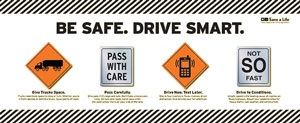I learned a very interesting fact the other day, and it has life-and-death implications for all of us who drive.
Up is Not Down
Most people understand the idea of peripheral vision. When you look at something in front of you, there is still a wide area to the sides that your eyes can see.
Not as many people have heard about their “peripheral” vision vertically. And they don’t know that up is very different from down.
This is very important for drivers to understand, because your vertical “peripheral” vision is not equally balanced.
You see extra visual information BELOW where you are focusing. But not much above.
When you are driving, your eyes can actually be looking above the traffic that’s directly in front of you (at traffic lights quite far ahead, for example), and you will still see the cars closest to you. If they slam their brakes on, you can still react to the visual information that’s important (brake lights flashing and an object getting larger as you get closer to it).
However, if your eyes are looking DOWN (at the radio dial, at the speedometer, at a phone…) you do not see the road … at all. If your eyes remain focussed on something below the windshield for more than a split second, you really are driving blind. You have no visual information at all about what is happening in the traffic in front of your car, and no opportunity to react to protect yourself.
For aging drivers, this is important because it’s a natural tendency to focus more intently as your vision changes. But looking LOWER, at the license plate of the car in front of you, is a poor choice. Not only does that reduce your actual field of view, it also gives you much less time to react, because you only see the hazards that are very close. If older drivers make the conscious effort to raise their gaze higher, they can drive much more safely.
For younger drivers, knowing this science fact about vision can help them build their driving skills. Much of the advantage of being an experienced driver seems to come as a kind of natural intuition. Mature drivers apparently tend to look down in fast glimpses, so when they change the radio station or check their speedometer, their eyes lose that view of the road for just a fraction of a second. Novice drivers do not always have that same instinct. Knowing the details of this small science fact can help teens develop this gut knowledge a little more quickly.
And to state the obvious, for anybody that has a cell phone, the implications are very very very clear. Looking down at a phone while driving is unsafe. A flick of the eyes downward is the most a driver should do … but phones require more time than that, whether it’s dialing or answering or ESPECIALLY texting. Driving blindfolded would be a phenomenally stupid thing to try … looking down at a phone is almost exactly the same risk in terms of your vertical vision.
If you can’t see the road, you aren’t driving safely. And if you’re looking down, it’s an undeniable fact that you really can’t see the road.




